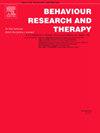Mechanisms of change in cognitive functional therapy: A longitudinal mediation analysis of the RESTORE clinical trial for disabling chronic low back pain
IF 4.5
2区 心理学
Q1 PSYCHOLOGY, CLINICAL
引用次数: 0
Abstract
Chronic low back pain (CLBP) is an urgent global health priority given its high prevalence and impact as the leading cause of disability. While several efficacious treatments exist, most have modest effects. Improving outcomes requires a better understanding of treatment mechanisms to enable optimisation. This study explored the mechanisms of cognitive functional therapy (CFT), a biopsychosocial intervention with large, durable effects for adults with disabling CLBP. A longitudinal mediation analysis was performed on data from the RESTORE multisite clinical trial comparing CFT (n = 327) to usual care (n = 165). Mediators (self-efficacy, fear, catastrophising, and pain intensity) were specified based on behavioural theories underlying CFT and previous research. The joint mediation of treatment effects on disability (Roland Morris Disability Questionnaire) and pain intensity (numerical rating scale), were examined using a counterfactual framework for mediation analysis. As hypothesised, earlier changes in self-efficacy, fear, catastrophising, and pain intensity mediated improvements in disability at the end of treatment and at 12-month follow-up, explaining up to 61 % of the effect. Similarly, self-efficacy, fear, and catastrophising mediated the effect of CFT on pain intensity, explaining up to 62 % of the effect. Results are consistent with previous CLBP mediation research highlighting self-efficacy, fear, and catastrophising as likely common mechanisms among effective biopsychosocial treatments. CFT demonstrates large, durable, and clinically important effects on these mechanisms. Findings shed light for clinicians and researchers on how CFT works, although the role of other mechanisms such as movement changes requires further exploration, along with research analysing how different treatment components activate these mechanisms.
认知功能治疗改变的机制:对慢性腰痛致残RESTORE临床试验的纵向中介分析
慢性腰痛(CLBP)是一个紧迫的全球卫生优先事项,因为它的高患病率和影响作为残疾的主要原因。虽然有几种有效的治疗方法,但大多数效果一般。改善结果需要更好地了解治疗机制以实现优化。本研究探讨了认知功能治疗(CFT)的机制,这是一种对成人致残性CLBP具有大而持久效果的生物心理社会干预。对RESTORE多地点临床试验的数据进行纵向中介分析,比较CFT (n = 327)和常规治疗(n = 165)。调节因子(自我效能、恐惧、灾难化和疼痛强度)是根据CFT的行为理论和先前的研究来指定的。采用反事实框架进行中介分析,考察了治疗效果对残疾(Roland Morris残疾问卷)和疼痛强度(数值评定量表)的联合中介作用。正如假设的那样,在治疗结束和12个月的随访中,自我效能、恐惧、灾难和疼痛强度的早期变化介导了残疾的改善,解释了高达61%的效果。同样,自我效能、恐惧和灾难化介导了CFT对疼痛强度的影响,解释了高达62%的影响。结果与先前的CLBP调解研究一致,强调自我效能、恐惧和灾难化可能是有效的生物心理社会治疗中的共同机制。CFT对这些机制具有巨大、持久和重要的临床作用。研究结果为临床医生和研究人员揭示了CFT的工作原理,尽管其他机制(如运动变化)的作用需要进一步探索,以及分析不同治疗成分如何激活这些机制的研究。
本文章由计算机程序翻译,如有差异,请以英文原文为准。
求助全文
约1分钟内获得全文
求助全文
来源期刊

Behaviour Research and Therapy
PSYCHOLOGY, CLINICAL-
CiteScore
7.50
自引率
7.30%
发文量
148
期刊介绍:
The major focus of Behaviour Research and Therapy is an experimental psychopathology approach to understanding emotional and behavioral disorders and their prevention and treatment, using cognitive, behavioral, and psychophysiological (including neural) methods and models. This includes laboratory-based experimental studies with healthy, at risk and subclinical individuals that inform clinical application as well as studies with clinically severe samples. The following types of submissions are encouraged: theoretical reviews of mechanisms that contribute to psychopathology and that offer new treatment targets; tests of novel, mechanistically focused psychological interventions, especially ones that include theory-driven or experimentally-derived predictors, moderators and mediators; and innovations in dissemination and implementation of evidence-based practices into clinical practice in psychology and associated fields, especially those that target underlying mechanisms or focus on novel approaches to treatment delivery. In addition to traditional psychological disorders, the scope of the journal includes behavioural medicine (e.g., chronic pain). The journal will not consider manuscripts dealing primarily with measurement, psychometric analyses, and personality assessment.
 求助内容:
求助内容: 应助结果提醒方式:
应助结果提醒方式:


